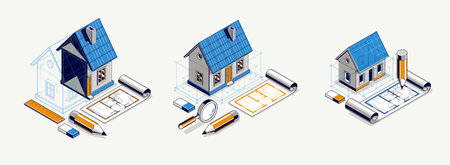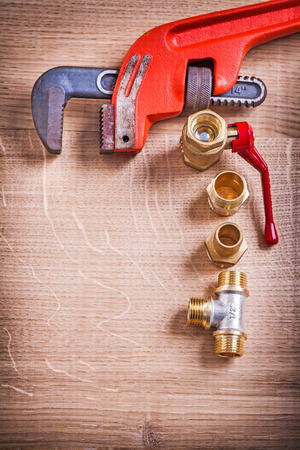1. Understand Your Home’s Style and Needs
Before you start shopping for plumbing fixtures, its important to get a clear sense of your homes overall style and how each room functions. Choosing the right fixtures isn’t just about picking something that looks good—it’s also about making sure it fits seamlessly with your homes design and supports your daily needs.
Match Fixtures to Your Interior Design Style
Your plumbing fixtures should enhance the look of your kitchen or bathroom, not clash with it. Whether your home leans more traditional, modern, farmhouse, or industrial, theres a fixture style to match. Heres a quick reference guide:
| Home Style | Recommended Fixture Finish | Fixture Design Features |
|---|---|---|
| Modern | Matte black, brushed nickel | Sleek lines, minimalistic shapes |
| Traditional | Polished chrome, brass | Classic curves, ornate details |
| Farmhouse | Oil-rubbed bronze, antique brass | Vintage-inspired, rustic elements |
| Industrial | Stainless steel, black metal | Exposed hardware, bold forms |
Consider Functionality and Daily Use
A fixture might look great—but will it work for your family? Think about how often the space is used and by whom. For example:
- If you have kids, choose durable and easy-to-clean materials.
- If you cook frequently, consider a pull-down kitchen faucet for added flexibility.
- If youre outfitting a guest bathroom, a simple but stylish faucet may be enough.
User-Friendly Features to Look For:
- Single-handle faucets: Easier temperature control with one hand.
- Ceramic disc valves: Reduce leaks and increase longevity.
- Tall spouts: More clearance when washing large pots or filling containers.
Select Fixtures That Support Water Efficiency
Aesthetic and function aside, water efficiency is key—especially in areas like California where water conservation matters. Look for fixtures labeled with WaterSense certification from the EPA. These use at least 20% less water than standard models without sacrificing performance.
Examples of Water-Efficient Fixture Types:
- Low-flow showerheads: Use less than 2 gallons per minute (GPM).
- Dual-flush toilets: Offer two flush options to save water.
- Aerated faucets: Mix air with water to reduce flow while maintaining pressure.
The better you understand your homes style and daily needs, the easier it becomes to choose plumbing fixtures that bring out the best in both form and function.
2. Know the Types of Plumbing Fixtures
Before choosing plumbing fixtures for your home, it’s important to understand the different types available and what they do. Each fixture plays a specific role in your bathroom or kitchen, and choosing the right one can impact both function and style.
Faucets
Faucets are one of the most visible plumbing fixtures in your home. They come in a variety of styles and finishes, from sleek modern designs to classic vintage looks. When selecting a faucet, consider how it will be used—kitchen faucets may need features like pull-down sprayers or touchless operation, while bathroom faucets focus more on design and water flow.
Common Faucet Types:
| Type | Description | Best For |
|---|---|---|
| Single-handle | One lever controls both temperature and flow. | Bathrooms, small sinks |
| Double-handle | Separate handles for hot and cold water. | Kitchens, traditional style bathrooms |
| Touchless | Sensors activate water flow without touching. | Kitchens, high-traffic bathrooms |
| Pull-down/Pull-out | Nozzle pulls out for flexible use. | Kitchens with large sinks |
Showerheads
Your shower experience depends heavily on the type of showerhead you choose. Options range from basic wall-mounted heads to luxurious rain showers and body sprays. Think about water pressure, spray settings, and energy efficiency when making your decision.
Main Showerhead Options:
- Wall-mounted: Simple and space-saving; most common type.
- Rain shower: Mounted on the ceiling or high wall; offers a spa-like feel.
- Handheld: Comes with a hose; ideal for kids, pets, and cleaning the shower area.
- Dual system: Combines fixed and handheld heads for versatility.
Sinks
Sinks serve both practical and decorative purposes in kitchens and bathrooms. The material, shape, and mounting style all play a part in how well a sink fits your needs and space.
Popular Sink Styles:
| Type | Description | Best For |
|---|---|---|
| Top-mount (Drop-in) | Sits on top of the counter; easy to install. | Kitchens and bathrooms with laminate countertops |
| Undermount | Mounted below countertop; creates a seamless look. | Kitchens with solid surface counters (granite, quartz) |
| Vessel | Bowl-shaped sink that sits above the counter. | Bathrooms with modern or artistic design themes |
| Farmhouse (Apron front) | Larger basin with exposed front panel. | Kitchens with rustic or country-style aesthetics |
Toilets
A toilet is an essential fixture that should offer comfort, efficiency, and style. When choosing one, look at flushing performance, water usage, height, and bowl shape. Modern toilets come with features like dual flush options to save water or elongated bowls for added comfort.
Main Toilet Features to Consider:
- Bowl Shape: Round bowls save space; elongated bowls offer more comfort.
- Height: Standard vs. comfort height (ideal for tall users or seniors).
- Flush Type: Single flush vs. dual flush for water conservation.
- One-piece vs. Two-piece: One-piece toilets are easier to clean; two-piece models are usually more affordable.
Selecting the right plumbing fixtures involves knowing what’s out there. By understanding each types purpose and style options, you’ll be better prepared to make choices that match your lifestyle and enhance your homes look and feel.

3. Consider Water Efficiency and Sustainability
When choosing plumbing fixtures for your home, its not just about looks or price—water efficiency and sustainability should also play a big role in your decision. Opting for water-saving fixtures can help you lower your utility bills and reduce your homes environmental impact.
Why Water Efficiency Matters
Using less water doesnt mean sacrificing performance. In fact, many modern plumbing fixtures are designed to use water more efficiently while still delivering great results. This means you can enjoy the same comfort and convenience while saving money and helping the planet.
Look for the WaterSense Label
The easiest way to identify water-efficient products is to look for the WaterSense label. This certification, backed by the U.S. Environmental Protection Agency (EPA), ensures that the product meets strict water-saving standards without compromising performance.
Benefits of Choosing WaterSense-Certified Fixtures:
| Fixture Type | Standard Flow Rate | WaterSense Flow Rate | Estimated Annual Savings* |
|---|---|---|---|
| Bathroom Faucet | 2.2 GPM | 1.5 GPM | $50/year per household |
| Showerhead | 2.5 GPM | 2.0 GPM or less | $70/year per household |
| Toilet | 1.6 GPF | 1.28 GPF or less | $110/year per household |
*Savings estimates based on average U.S. household usage and rates.
Sustainable Choices Beyond WaterSense
In addition to choosing WaterSense-certified products, consider materials and manufacturing processes when selecting your fixtures. Look for brands that use recycled materials, offer long-lasting warranties, and prioritize eco-friendly production methods.
Quick Tips for a Greener Home:
- Select low-flow faucets and showerheads with aerators.
- Install dual-flush toilets to control how much water you use per flush.
- Fix leaks promptly to prevent unnecessary water waste.
- Choose durable fixtures that won’t need frequent replacement.
By making smart choices today, youre investing in a more sustainable future for your home—and saving money along the way.
4. Focus on Quality and Material Durability
When choosing plumbing fixtures for your home, it’s important to look beyond just style and price. The materials used in your faucets, showerheads, and other plumbing hardware play a huge role in how long they’ll last and how well they’ll perform over time. Some materials are more durable and resistant to corrosion, wear, and water damage—making them smarter long-term investments.
Top Durable Materials to Consider
Here’s a quick breakdown of some of the most reliable materials used in plumbing fixtures:
| Material | Benefits | Best For |
|---|---|---|
| Brass | Highly durable, corrosion-resistant, and antimicrobial. Brass fixtures can last for decades with minimal maintenance. | Kitchens, bathrooms, outdoor fixtures |
| Stainless Steel | Rust-resistant, sleek-looking, and ideal for modern designs. It’s also easy to clean and hygienic. | Kitchens, utility rooms, contemporary bathrooms |
| Ceramic | Scratch-resistant and doesnt corrode or rust. Often used in valve components for smooth operation. | Valve cartridges, sink handles, decorative elements |
What to Avoid
Certain materials might be cheaper upfront but could cost you more in repairs or replacements down the road. Here are a few to watch out for:
- Zinc Alloys (e.g., Zamak): These are commonly used in low-cost fixtures but tend to corrode faster and break down over time.
- Plastic Components: While lightweight and inexpensive, plastic parts often crack or wear out quickly—especially in high-use areas.
- Poor Finishes: Fixtures with thin or poor-quality finishes may peel or tarnish easily, especially when exposed to moisture and cleaning chemicals.
Quick Tips for Choosing Long-Lasting Fixtures
- Look for solid brass bodies with ceramic disc valves for faucets—theyre known for longevity and leak prevention.
- If budget allows, go for stainless steel over chrome-plated plastic—it holds up better under daily use.
- Check product warranties; longer warranties often indicate better build quality.
Selecting quality materials ensures your plumbing fixtures stay looking good and working well for years to come. It might cost a bit more upfront, but the durability pays off over time.
5. Set a Realistic Budget and Factor in Installation Costs
Choosing the right plumbing fixtures for your home isn’t just about style or brand—it’s also about making smart financial decisions. Setting a realistic budget helps you stay on track and avoid overspending. At the same time, its important to remember that the price of the fixture is only part of the total cost. Youll also need to account for installation fees and possible plumbing upgrades.
Understand What Affects Fixture Costs
There are several factors that can influence how much you’ll spend on plumbing fixtures:
- Material quality: Solid brass or stainless steel fixtures tend to last longer but cost more upfront.
- Brand reputation: Well-known brands may charge more but often come with better warranties and customer support.
- Design complexity: Touchless faucets or rain shower heads can add convenience, but they’re typically pricier.
Don’t Forget About Installation Costs
Even if you find a great deal on a faucet or showerhead, you still need to pay someone to install it—unless youre comfortable doing it yourself. Professional installation ensures everything is up to code and reduces the risk of leaks or future issues.
Typical Installation Cost Estimates
| Fixture Type | Average Cost (Fixture Only) | Professional Installation |
|---|---|---|
| Bathroom Faucet | $50 – $300 | $100 – $250 |
| Kitchen Faucet | $75 – $500 | $150 – $300 |
| Shower System | $150 – $1,000+ | $300 – $800+ |
| Toilet | $100 – $600 | $150 – $400 |
Balance Quality and Cost
You don’t always have to buy top-of-the-line products to get good performance. Look for mid-range options from reputable brands that offer solid warranties. Consider whether certain features—like water-saving tech or touchless controls—are worth the extra cost based on your lifestyle and needs.
Plan for Hidden or Future Costs
If youre updating older plumbing, you might run into surprises like outdated pipes or valves that need replacing. Its wise to set aside an extra 10-20% of your budget for unexpected issues. This cushion can help cover last-minute adjustments without delaying your project.
Quick Tip:
If you’re remodeling more than one bathroom or updating multiple fixtures at once, ask your plumber about bulk installation discounts. Some professionals offer lower rates when doing several installs in one visit.
The key is to plan ahead, shop smart, and make room in your budget for both product and labor costs. That way, you can enjoy beautiful, functional plumbing fixtures without breaking the bank.


